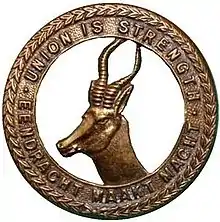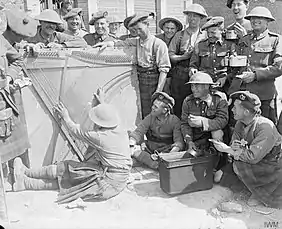South African Overseas Expeditionary Force
The South African Overseas Expeditionary Force (SAOEF) was a volunteer military organisation in World War I.
| Part of a series on the |
| Military history of South Africa |
|---|
| Conflicts |
| National Defence Force |
| Historical forces |
| Lists |
| South African Overseas Expeditionary Force | |
|---|---|
 Cap badge of the 1st SA Infantry Brigade | |
| Active | 1915–1919 |
| Disbanded | 1919 |
| Country | |
| Allegiance | |
| Branch | Army |
| Type | Infantry |
| Engagements | Egypt Campaign (1916) Western Front Campaign (1916–1918) German East Africa Campaign (1916–1918) Palestine Campaign (1917–1918) |
| Decorations | Pte William Frederick Faulds VC L Cpl William Henry Hewitt VC Captain William Anderson Bloomfield VC |
| Battle honours | Belatedly awarded to the 1915 Cape Corps in 1973:
|
| Commanders | |
| Notable commanders | Lt-Genl Jan Smuts Lt-Genl Sir Jacob van Deventer Maj-Genl Sir Henry Timson Lukin |
Organisation
The South African government formed the South African Overseas Expeditionary Force (SAOEF) in July 1915, as its contribution to the British war effort against the Central Powers. As South African legislation restricted the Union Defence Forces (UDF) to operating in southern Africa, an entirely new force, made up of volunteers, had to be raised for service in other theatres of war. As they were not officially a South African force, the SAOEF was placed under British operational command for operations on the Western Front.[Note 1]
Many volunteers came from UDF units, but they enrolled as individuals, not as contingents, and there was no formal link between SAOEF and UDF units as such.
The SAOEF consisted of several arms of service:
- 1st South African Infantry Brigade. The brigade was commanded by Brigadier General H.T. (Tim) Lukin and consisted of four regiments[1] recruited from existing military units as well as amongst civilians. Regiments were raised in the four provinces of South Africa:
- The 1st SA Infantry Regiment was commanded by Lt Col F.S. Dawson with the regiment being raised from the Cape Province and known as "The Cape Regiment." A Company (Western Province) was made up from men mostly from the Duke of Edinburgh's Rifles. B. Company was recruited from the Eastern Province and C Company was from Kimberley, with many of the men being ex Kimberley Regiment. D Company was recruited from Cape Town.[2]
- The 2nd South African Infantry Regiment was commanded by Lt Col W.E.C. Tanner, this Regiment was raised from Natal and Orange Free State. Many volunteers were from the Kaffrarian Rifles.[3]
- The 3rd South African Infantry Regiment. Commander: Lt Col E.F. Thackeray and raised from Transvaal and Rhodesia. The regiment was generally known as "The Transvaal Regiment." B Company were mostly from the Witwatersrand Rifles while C Company were men from the Rand Light Infantry.[4]
- The 4th SA Infantry Infantry Regiment was led by Lt Col F.A. Jones, DSO and became known as the "South African Scottish." Lt Col Jones was killed in fighting in Benfray Wood on 11 July 1916 and was replaced at the Battle of Delville Wood by Major D.M. MacLeod.[5] The regiment was raised from the Cape Town Highlanders Regiment and the area of Cape Town (A Company) while members of 1st Bn Transvaal Scottish Regiment made up most of B Company. C Company came from 2nd Bn Transvaal Scottish Regiment and recruits encouraged by the Caledonian Societies of Natal and Orange Free State made up D Company.[3]
- SA Heavy Artillery Brigade. On the Western Front, the brigade was armed with 6" Howitzers and was placed under command of the Royal Garrison Artillery, consisting of (April 1916):[6]
- 71st Siege Battery, RGA
- 72nd Siege Battery, RGA
- 73rd Siege Battery, RGA
- 74th Siege Battery, RGA
- SA Field Artillery
- SA Horse (mounted rifles): ten battalions
- SA Rifles (dismounted rifles): two battalions
- Cape Corps: two infantry battalions and a labour battalion
- Engineer, signals, supply and transport, medical, and veterinary units
- South African Native Labour Corps
SAOEF units and formations did not serve as distinct South African forces, but were integrated into the British imperial armies and divisions in the field.
Campaigns
The SAOEF fought in four campaigns.
German East Africa Campaign (1916–1918)
During the East African Campaign (World War I), there was strong South African participation and leadership. SA Field Artillery, the 1st and 2nd SA Mounted Brigades, the 2nd and 3rd SA Infantry Brigades, and the Cape Corps fought in British operations against German forces in German East Africa (now Tanzania) from January 1916 until the war in Africa ended on 25 November 1918. Two South African generals, Lt. Gen. Jan Smuts and Lt. Gen. Sir Jacob van Deventer, commanded the operations. Their major battles were: Salaita Hill, Kilimanjaro, and Kondoa-Irangi in 1916; and Behobeho, Narungombe, and Nyangao in 1917.
Captain William Anderson Bloomfield won the Victoria Cross for gallantry.
Egypt Campaign (1916)
The 1st SA Infantry Brigade was deployed in British operations against the Sanusi in Egypt from January to March 1916. It fought in the Action of Halazin and the Action of Agagiya.
Western Front Campaign (1916–1918)

The SA Heavy Artillery and the 1st SA Infantry Brigade fought in the trenches of the Western Front against German forces in France and Belgium, from May 1916 until the war in Europe ended on 11 November 1918. They fought in the battles of the Somme in 1916; Arras, Ypres, and Menin in 1917; and Passchendaele, Messines, Mont Kemmel, and Cambrai in 1918.
The two events of the campaign that are still commemorated are the Battle of Delville Wood (part of the Somme offensive), and the sinking of the troopship SS Mendi, with the loss of more than 600 African members of the South African Native Labour Corps (1917).
Two SAOEF members, Pte William Frederick Faulds and L Cpl William Henry Hewitt, won the Victoria Cross for gallantry.
Palestine Campaign (1917–1918)
The SA Field Artillery and the Cape Corps fought in British operations against Turkish forces in Palestine from August 1917 until the end of the war in November 1918. They fought in the battles of Gaza, El Mughar, and Nebi Samwil in 1917; and Tel Asur, Battle of Megiddo 1918, Sharon, and Nablus in 1918.
Disbandment
The SAOEF units and formations were disbanded in 1919. As there were no formal links between SAOEF units and the Union Defence Forces units which had provided their initial manpower, the SAOEF's war record, including its many honours, was not perpetuated by the UDF (except for the Cape Corps battle honours, which were allowed to the SA Cape Corps Service Battalion formed in 1973).
Notes
- The South African Union Defence Act of 1914 prohibited the deployment of South African troops beyond the borders of the South Africa and its immediate neighbouring territories. In order to send troops to Europe to support the Commonwealth in World War I, Generals Botha and Smuts created the South African Overseas Expeditionary Force. However, because of the limitations of the Defence Act, they issued a General Order (Order 672 of 1915) which stated that The South African Overseas Expeditionary Force will be Imperial and have the status of regular British Troops. "Status" was meant to imply administrative purposes, as Britain was paying for the maintenance of the force in the field for the sake of local political sensitivities. Regrettably, this Administrative Order later meant that the South African units which served as part of the Overseas Expeditionary Force were not, as South African units, entitled to retain Regimental Colours awarded to them for battles fought as "British" units. The 1st Infantry Brigade Group was the first unit to be formed as a constituent part of the South African Overseas Expeditionary Force. Reference Digby p.146
Citations
- S Afr MHJ Vol 7 No 2
- Digby p. 18
- Digby p. 19
- Digby p. 19
- Buchan p.55
- Buchan Appendix 1
References
- Adler, F; Lorch A.E.; Curson, H.H. (1958). The South African Field Artillery in German East Africa and Palestine.
- Brown, J.A. (1991) They Fought for King and Kaiser.
- Buchan, John (1992). The history of the South African forces in France (Litho reprint of 1920 ed.). London: Imperial War Museum & Battery Press. ISBN 0-901627-89-5.
- Collyer, J.J. (1939). The South Africans with General Smuts in German East Africa.
- Digby, Peter. K. (1993). Pyramids and Poppies: The 1st SA Infantry Brigade in Libya, France and Flanders: 1915–1919. Rivonia: Ashanti. ISBN 1-874800-53-7.
- Historicus Africanus; "Der 1. Weltkrieg in Deutsch-Südwestafrika 1914/15", Band 1, Eine Chronik der Ereignisse seit dem 30.Juni 1914, 2. Auflage, Glanz & Gloria Verlag, Windhoek 2012
- Historicus Africanus; "Der 1. Weltkrieg in Deutsch-Südwestafrika 1914/15", Band 2, Naulila, Glanz & Gloria Verlag, Windhoek 2012
- Historicus Africanus; "Der 1. Weltkrieg in Deutsch-Südwestafrika 1914/15", Band 3, Kämpfe im Süden, Glanz & Gloria Verlag, Windhoek 2014
- Historicus Africanus; "Der 1. Weltkrieg in Deutsch-Südwestafrika 1914/15", Band 4, Der Süden ist verloren, Glanz & Gloria Verlag, Windhoek 2016
- Historicus Africanus; "Der 1. Weltkrieg in Deutsch-Südwestafrika 1914/15", Band 5, Aufgabe der Küste, Glanz & Gloria Verlag; Windhoek 2016
- Miller, C. (1974). Battle for the Bundu.
- Nothling, C.J. (1994). Suid-Afrika in die Eerste Wereldoorlog.
- Uys, Ian (1973). For Valour – The Story of South Africa's Victoria Cross Recipients.
- Uys, Ian (1983). Delville Wood.
- "The South African Military History Society". The South Africans at Delville Wood. pp. Military History Journal (S Afr MHJ) – Vol 7 No 2. Archived from the original on 25 July 2009. Retrieved 23 July 2009.